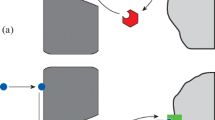Summary
-
1.
The stylets of the blood-sucking bugTriatoma infestans are innervated by mechanoreceptors. The dimensions of the dendrite in one of the three receptor cells of the right maxillary stylet were evaluated: it was about 10 mm long and 0.8 μm in diameter.
-
2.
Following repetitive brief mechanical stimulation of the tip of the stylet, impulses were recorded from the sensory nerve. The delay between the stimulation and the first propagated potential was about 9 msec.
-
3.
Responses of the nerve are also obtained by means of mechanical stimulation from different parts of the stylet.
-
4.
It was not possible to record spikes or receptor potential with the aid of a micropipette brought in contact with the intact or sectioned tip of the stylet.
-
5.
The length of the maxillary nerve (2 mm) permitted the application of antidromic stimulation, and ruled out local emission of impulses and all-or-nothing propagation of impulses in the dendrite.
-
6.
Electrotonic transmission of a receptor potential is possible if we admit that the resistance of the dendrite alone or of the dendrite with its cuticular sheath is very high.
Similar content being viewed by others
Bibliographie
Atema, J.: Microtubule theory of sensory transduction. J. theor. Biol.38, 181–190 (1973)
Bennett, M. V. L.: Comparative physiology: electric organs. Ann. Rev. Physiol.32, 471–528 (1970)
Bernard, J.: Mécanisme d'ouverture de la bouche chez un insecte hématophage,Triatoma infestans. J. Insect Physiol. (sous presse) (1973)
Boeckh, J.: Electrophysiologische Untersuchungen an einzelnen Geruchsrezeptoren auf den Antennen des Totengräbers (Necrophorus, Coleoptera). Z. vergl. Physiol.46, 212–248 (1962).
Boistel, J.: Quelques caractéristiques électriques de la membrane de la fibre nerveuse au repos d'un insecte (Periplaneta americana). C.R. Soc. Biol. (Paris)153, 1009–1013 (1959)
Edwards, C., Ottoson, D.: The site of impulse initiation in a nerve cell of a crustacean stretch receptor. J. Physiol. (Lond.)143, 138–148 (1958)
Garcia-Ramos, J.: On the physiology of dendrites. Currents in modern biology, 3, p. 74–84. Amsterdam: North Holland Publishing Co. 1969
Guillet, J. C., Bernard, J.: Shape and amplitude of the spikes induced by natural or electrical stimulation in insect receptors. J. Insect Physiol.18, 2155–2171 (1972)
Hagins, W. A., Penn, R. D., Yoshikami, S.: Dark current and photocurrent in retinal rods. Biophys. J.10, 380–412 (1970)
Hodgkin, A. L.: The membrane resistance of a non medullated nerve fibre. J. Physiol. (Lond.)106, 305–318 (1947)
Kaissling, K. E.: In: Handbook of sensory physiology. Chemical senses 1, Insect olfaction, vol. IV, p. 351–431, ed. L. M. Beidler. Berlin-Heidelberg-New York: Springer 1971
Katz, B.: Nerve muscle and synapse, ed. G. Wald. New-York: Mc Graw-Hill Book Co. 1966
Llinas, R., Nicholson, C.: Electrophysiological properties of dendrites and somata in Alligator Purkinje cells. J. Neurophysiol.34, 532–548 (1971)
Mellon de, F., Kennedy, D.: Impulse origin and propagation in a bipolar sensory neuron. J. gen. Physiol.47, 487–499 (1964)
Mendelson, M.: The site of impulse initiation in bipolar receptor neurons ofCallinectes sapidus L. J. exp. Biol.45, 411–420 (1966)
Pinet, J. M.: L'innervation sensorielle des stylets mandibulaires et maxillaires deBhodnius prolixus. C.R. Acad. Sci. (Paris)257, 366–368 (1963)
Pinet, J. M.: Recherches sur les stylets mandibulaires et maxillaires deRhodnius prolixus.` Thèse d'Etat, Paris, 253 p. (1970)
Pinet, J. M., Bernard, J., Boistel, J.: Etude électrophysiologique des récepteurs des stylets chez une punaise hématophage:Triatoma infestans. C.R. Soc. Biol. (Paris)163, 1939–1948 (1969)
Schneider, D.: Electrophysiologische Untersuchungen von Chemo- und Mecanorezeptoren der Antenne des SeidenspinnersBombyx mori L. Z. vergl. Physiol.40, 8–41 (1957)
Schneider, D., Steinbrecht, R. A.: Checklist of insect olfactory sensilla. Symp. Zool. Soc. London23, 279–297 (1968)
Shaw, S. R.: Decremental conduction of the visual signal in barnacle lateral eye. J. Physiol. (Lond.)220, 145–175 (1972)
Slifer, E. H.: Thin walled olfactory sense organs on insect antennae. In: Insects and physiology, eds. J. W. L. Beament and J. E. Treherne, p. 232–245. Edinburg-London 1967
Slifer, E. H.: The structure of arthropod chemoreceptors. Ann. Rev. Entomol.15, 121–142 (1970)
Thurm, U.: Mechanoreceptors in the cuticule of the honey-bee: fine structure and stimulus mechanism. Science145, 1063–1065 (1964)
Thurm, U.: An insect mechanoreceptor. Cold Spr. Harb. Symp. quant. Biol.30, 75–82 (1965)
Thurm, U.: General organization of sensory receptors. Estratto da Rendiconti delle Scuola Internationale di fisica “E FERMI”43, 44–68 (1970)
Thurm, U.: On the functional organization of sensory epithelia. Verh. dtsch. zool. Ges.64, 79–88 (1970)
Author information
Authors and Affiliations
Additional information
Les auteurs remercient le Dr. Y. Pichon et J. C. Guillet pour les critiques et suggestions qu'ils ont bien voulu leur faire, et Mme J. Le Guen pour sa collaboration technique.
Rights and permissions
About this article
Cite this article
Bernard, J., Pinet, J.M. Origine des potentiels propagés dans un mécanorécepteur à dendrite longue. J. Comp. Physiol. 87, 361–377 (1973). https://doi.org/10.1007/BF00695270
Received:
Issue Date:
DOI: https://doi.org/10.1007/BF00695270




